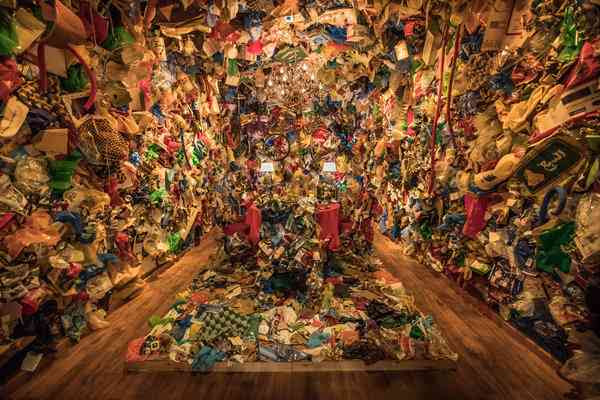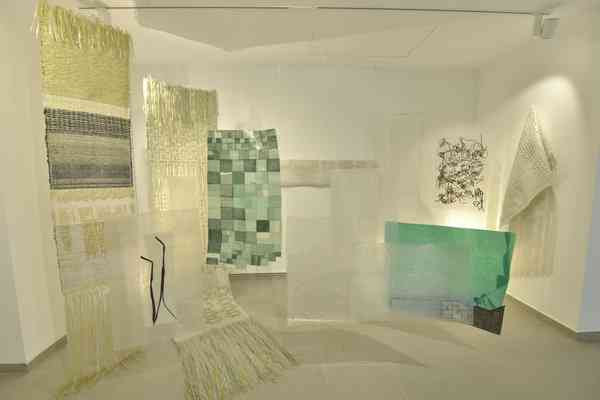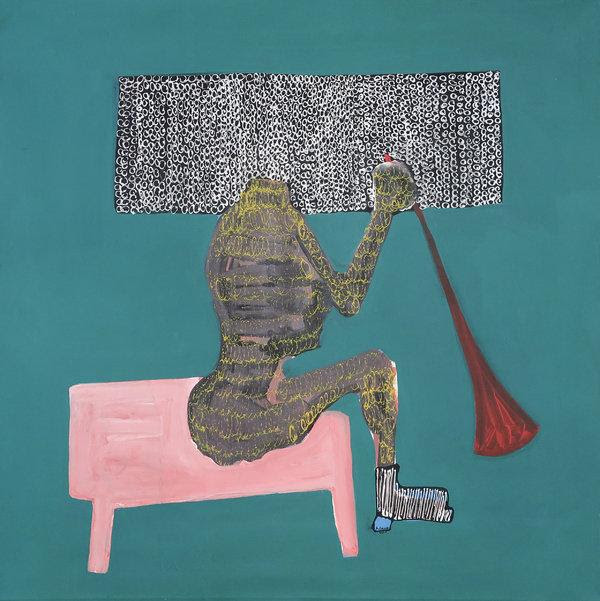New York Times
By Scott Reyburn
The collective Zbel Manifesto used plastic garbage from daily life to create “A Dinner in Town.” It’s part of the exhibition “Second Life” at the new Museum of African Contemporary Art Al Maaden in Marrakesh, Morocco.Museum of African Contemporary Art Al Maaden
MARRAKESH, Morocco — “If you come to Marrakesh, you don’t come to see contemporary art,” Othman Lazraq, president of the Museum of African Contemporary Art Al Maaden told journalists before the opening of his independent museum. “You come to see camels and dancing ladies.”
Mr. Lazraq, 29, son of the multimillionaire Moroccan real estate developer and art collector Alami Lazraq, might have had his tongue firmly in cheek, yet his remark summed up popular perceptions of Marrakesh.
Now the city, once the capital of medieval African empires, hopes to become a destination for art. The Lazraqs’ museum, the first nonprofit museum of its kind in North Africa, formally opened on Feb. 24, one day after the inaugural 1-54 Contemporary African Art Fair started at the La Mamounia Palace Hotel. The openings filled the gap created by the cancellation of the seventh Marrakesh Biennale after its founder, Vanessa Branson, withdrew her support.
“We thought it was important to show contemporary African art in the African continent,” said Touria El Glaoui, the founding director of the 1-54 fair. The fair, which was founded in London in 2013 and branched out to New York in 2015, now spans three continents. “But we wanted to find a spot where visitors can come to Africa and be O.K. with it,” said Ms. El Glaoui, alluding to the relative stability of the Morocco, whose monarch, King Mohammed VI, has his own museum of modern and contemporary art in Rabat. “We also need African collectors to collect their own art,” Ms. El Glaoui added.
Africa has been one of the art world’s Next Big Things for a while. But owing to the sheer scale, diversity and geopolitical challenges of the continent, African artists still struggle to achieve international recognition.
“Calibrated Compositions III,” by Soukaina Aziz El Idrissi, reimagines Moroccan carpets and textiles using plastic.Courtesy of Soukainia Aziz El Idrissi
There are few more comfortable spots than La Mamounia (Winston Churchill was a frequent guest). The exclusivity of the venue, as well as its iron gates manned by security guards, certainly made many European and American visitors feel at ease. A significant proportion own properties in Marrakesh, which has been a magnet for cultured wealth ever since Yves Saint Laurent made a home in the city.
“I prefer boutique fairs,” said Primo Marella, director of the Primo Marella Gallery in Milan and Lugano, one of just 17 exhibitors at 1-54. “They attract fewer collectors, but they are more specific.”
The Marrakesh fair attracted 4,000 visitors from Thursday through Sunday, according to the organizers, less than a third of the attendance at last year’s London fair. But many were collectors with plenty of money to spend — ensuring sales.
By the end of Friday, Mr. Marella said he had sold three textile wall hangings by the Mali-based artist Abdoulaye Konaté made specially for the fair. P riced as high as 25,000 euros each, or around $30,000, they went to collectors based in France, Morocco and Portugal.
Mr. Konaté’s enigmatic, politically charged hangings, inspired by local textile traditions, first came to prominence in the much-exhibited Contemporary African Art Collectionformed by the Italian businessman Jean Pigozzi. That collection, which still guides many buyers’ incursions into contemporary African art, was formed in 1989 under the guidance of André Magnin, a French curator and dealer.
Mr. Magnin’s Paris gallery, Magnin-A, was doing brisk business at the fair, selling 10 works by Friday afternoon for prices ranging from €2,500 to €22,000, by artists such J.P. Mika from Congo and Amadou Sanogo from Mali. The latter’s wry 2017 canvas, “Untitled,” showing a headless figure holding a paddle, sold for €16,000.
A 2017 painting by the Mali-based artist Amadou Sanogo was sold by the Paris gallery Magnin-A for about $20,000.Cyrille Martin/Mangin-A Gallery, Paris
As these price points suggest, African contemporary art tends to be more reasonably priced than equivalent works by American or European artists.
Tunji Akintokun, an I.T. executive based in London, described African contemporary art as “underestimated and undervalued.” He flew to Marrakesh for the fair, attracted by its North African emphasis.
“Most of my collection is sub-Saharan,” he said. “It was an opportunity to be educated, but also to look at the potential to buy.”
Mr. Akintokun said that he was negotiating to purchase two North African works for his collection, but he declined to name the artists.
Mr. Akintokum might have been looking, for example, at photographs by the Moroccan artist Walid Layadi-Marfouk, 22, who is based in New York. The London gallery Tiwani sold one of his photographs — of his aunt in his great-grandfather’s ancestral mansion in Marrakesh — for $5,000. Others were included in a survey show of works by 40 photographers, “Africa Is No Island,” at the contemporary art museum.
Over 9,700 square feet of exhibition space over two floors, the museum presents the most comprehensive overview of how North African artists are responding to our times by showcasing works from the 2,000-piece collection of Alami and Othman Lazraq. Many of the artists are from Morocco. For several, plastic garbage has become the medium — and the message — of the moment.
Abdoulaye Konaté’s 2018 textile hanging “Blue-gray Composition With Red Beak” was also sold at the 1-54 Contemporary African Art Fair.Primo Marella
The Marrakech-based collective Zbel Manifesto, comprising Ghizlane Sahli, Katia Sahli and Othman Zine, has used “daily life garbage” to create an entire dining room, complete with formal place settings for the exhibition “Second Life” on the museum’s upper floor. Titled “Un dîner en ville,” or “A Dinner in Town,” the immersive installation is a lurid allegory of consumer excess.
The Casablanca-based artist Soukaina Aziz El Idrissi, on the other hand, takes the ugliness of plastic waste, then heats and weaves it into translucent hangings that lyrically reimagine the carpets and textiles for sale in Morocco’s souks.
“In Morocco, carpets were art, until Westerners came in and said they weren’t,” said Ms. Aziz El Idrissi, 30, who trained at Central St. Martins college, the London art and design college. Her installation of hangings, “Calibrated Compositions III,” is on display on the second floor. “We have too much plastic,” said Ms. Idrissi, who in 2016 made a maze out of 17 tons of polyethylene bottles in Marrakesh to coincide with the COP22 climate change conference. “Let’s stop.”
It’s easy enough see the disconnect between internationally minded contemporary art shown in luxury hotels and millionaires’ private museums and the lives being lived in the surrounding communities. The opening last fall of the grandiose Zeitz Museum of Contemporary Art Africa in Cape Town — hailed as Africa’s answer to Tate Modern — also drew attention to this issue.
But Othman Lazraq, the Moroccan collector who is president of his own museum, is eager to connect with Moroccans and, possibly, to inspire more of them to become artists. The museum runs an active program of artists’ workshops, talks and screenings for schools and universities. It has also started “La Chambre Claire,” a biannual photography prize for emerging African artists.
“Photography is the medium of my generation. It’s the easiest way to see things clearly.” Mr. Lazraq said, adding that he wanted his museum give African artists “a platform to be proud of their roots.”
But gaining wider recognition remains a challenge for African artists. Encouraging international visitors to look at their art in Africa can only help that process.









